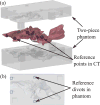Through the Eustachian Tube and Beyond: A New Miniature Robotic Endoscope to See Into The Middle Ear
- PMID: 29202035
- PMCID: PMC5708577
- DOI: 10.1109/LRA.2017.2668468
Through the Eustachian Tube and Beyond: A New Miniature Robotic Endoscope to See Into The Middle Ear
Abstract
This paper presents a novel miniature robotic endoscope that is small enough to pass through the Eustachian tube and provide visualization of the middle ear (ME). The device features a miniature bending tip previously conceived of as a small-scale robotic wrist that has been adapted to carry and aim a small chip-tip camera and fiber optic light sources. The motivation for trans-Eustachian tube ME inspection is to provide a natural-orifice-based route to the ME that does not require cutting or lifting the eardrum, as is currently required. In this paper, we first perform an analysis of the ME anatomy and use a computational design optimization platform to derive the kinematic requirements for endoscopic inspection of the ME through the Eustachian tube. Based on these requirements, we fabricate the proposed device and use it to demonstrate the feasibility of ME inspection in an anthropomorphic model, i.e. a 3D-printed ME phantom generated from patient image data. We show that our prototype provides > 74% visibility coverage of the sinus tympani, a region of the ME crucial for diagnosis, compared to an average of only 6.9% using a straight, non-articulated endoscope through the Eustachian Tube.
Keywords: Medical Robots and Systems; Steerable Catheters/Needles; Surgical Robotics.
Figures










Similar articles
-
Eyes in Ears: A Miniature Steerable Digital Endoscope for Trans-Nasal Diagnosis of Middle Ear Disease.Ann Biomed Eng. 2021 Jan;49(1):219-232. doi: 10.1007/s10439-020-02518-9. Epub 2020 May 26. Ann Biomed Eng. 2021. PMID: 32458223 Free PMC article.
-
Transeustachian Middle Ear Endoscopy Using a Steerable Distal-Camera Tipped Endoscope.Otol Neurotol. 2022 Feb 1;43(2):206-211. doi: 10.1097/MAO.0000000000003384. Otol Neurotol. 2022. PMID: 34669684 Free PMC article.
-
Steerable Robot-assisted Micromanipulation in the Middle Ear: Preliminary Feasibility Evaluation.Otol Neurotol. 2017 Feb;38(2):290-295. doi: 10.1097/MAO.0000000000001288. Otol Neurotol. 2017. PMID: 27861302
-
Panel 2: Anatomy (Eustachian Tube, Middle Ear, and Mastoid-Anatomy, Physiology, Pathophysiology, and Pathogenesis).Otolaryngol Head Neck Surg. 2017 Apr;156(4_suppl):S22-S40. doi: 10.1177/0194599816647959. Otolaryngol Head Neck Surg. 2017. PMID: 28372527 Review.
-
Miniature in vivo robotics and novel robotic surgical platforms.Urol Clin North Am. 2009 May;36(2):251-63, x. doi: 10.1016/j.ucl.2009.02.013. Urol Clin North Am. 2009. PMID: 19406325 Review.
Cited by
-
Coupling Analysis of Compound Continuum Robots for Surgery: Another Line of Thought.Sensors (Basel). 2023 Jul 14;23(14):6407. doi: 10.3390/s23146407. Sensors (Basel). 2023. PMID: 37514701 Free PMC article.
-
Computational Optimization of Notch Spacing for a Transnasal Ear Endoscopy Continuum Robot.Int Symp Med Robot. 2020 Nov;2020:188-194. doi: 10.1109/ismr48331.2020.9312937. Epub 2021 Jan 11. Int Symp Med Robot. 2020. PMID: 36844884 Free PMC article.
-
MR-Tracked Deflectable Stylet for Gynecologic Brachytherapy.IEEE ASME Trans Mechatron. 2022 Feb;27(1):407-417. doi: 10.1109/tmech.2021.3064954. Epub 2021 Mar 9. IEEE ASME Trans Mechatron. 2022. PMID: 35185321 Free PMC article.
-
Functional aspects of the Eustachian tube by means of 3D-modeling.PLoS One. 2021 Aug 12;16(8):e0244909. doi: 10.1371/journal.pone.0244909. eCollection 2021. PLoS One. 2021. PMID: 34383758 Free PMC article.
-
Eyes in Ears: A Miniature Steerable Digital Endoscope for Trans-Nasal Diagnosis of Middle Ear Disease.Ann Biomed Eng. 2021 Jan;49(1):219-232. doi: 10.1007/s10439-020-02518-9. Epub 2020 May 26. Ann Biomed Eng. 2021. PMID: 32458223 Free PMC article.
References
-
- Burgner-Kahrs J, Rucker DC, Choset H. Continuum robots for medical applications: A survey. IEEE Transactions on Robotics. 2015;31(6):1261–1280.
-
- Zhang D, Bennett ML, Labadie RF, Noble JH. Simulation of trans-nasal endoscopy of the middle ear for visualization of cholesteatoma. 2015 IEEE 12th International Symposium on Biomedical Imaging (ISBI) 2015 Apr;:1415–1418.
-
- Wallis S, Atkinson H, Coatesworth AP. Chronic otitis media. Postgraduate Medicine. 2015;127(4):391–395. - PubMed
-
- Browning GG, Gatehouse S. The prevalence of middle ear disease in the adult british population. Clinical Otolaryngology & Allied Sciences. 1992;17(4):317–321. - PubMed
-
- Hannula S, Bloigu R, Majamaa K, Sorri M, Mki-Torkko E. Ear diseases and other risk factors for hearing impairment among adults: an epidemiological study. International Journal of Audiology. 2012;51(11):833–840. - PubMed
Grants and funding
LinkOut - more resources
Full Text Sources
Other Literature Sources
